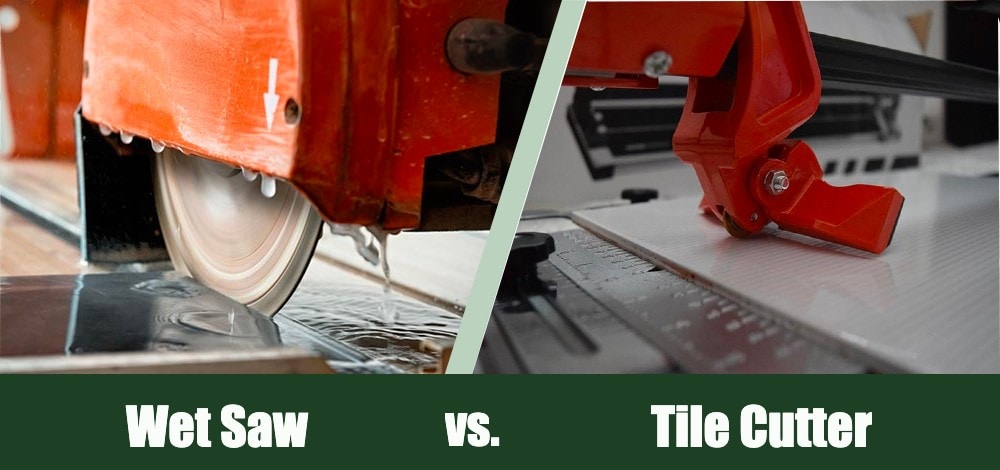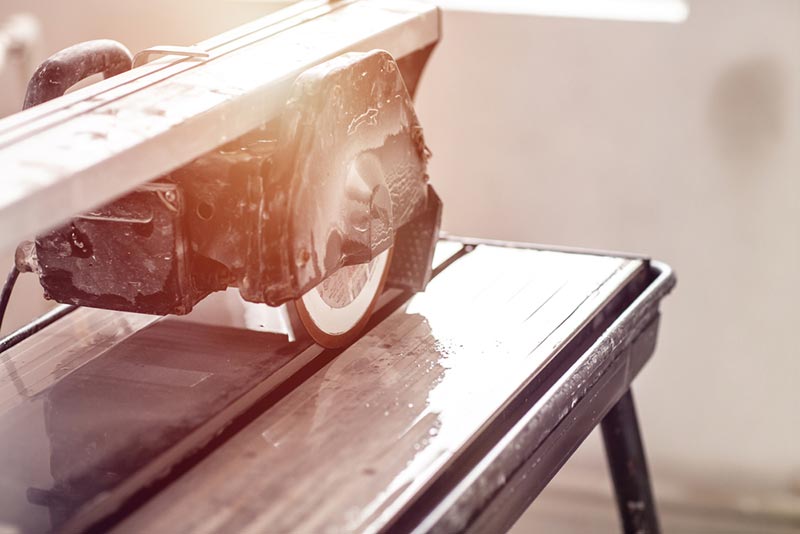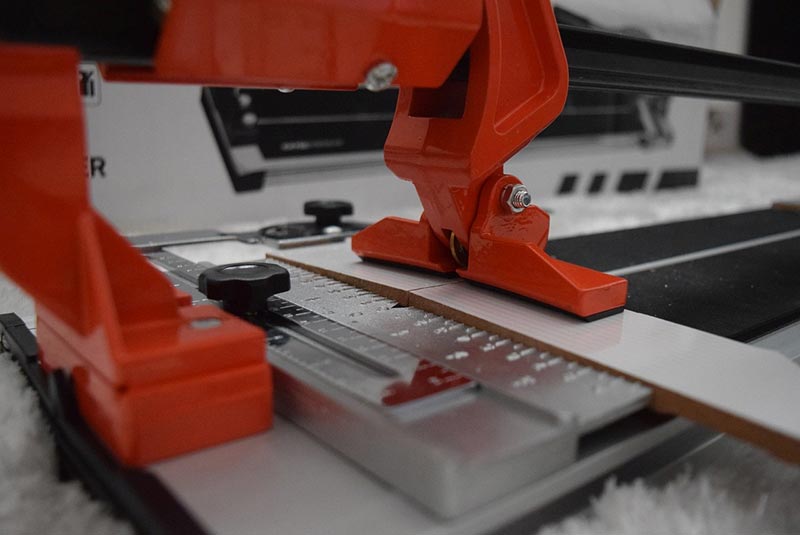Wet Saw vs. Tile Cutter: Which is the Better Option?
-
Pete Ortiz
- Last updated:

If you are looking to replace your floor with tiles or install tiles onto your countertop by yourself, you need to know the right equipment for the job, especially when you need to cut the tiles. The most common tools are usually a tile cutter or a wet saw.
In this article, we’ll help you pick the best tool between the two depending on the project.
Choosing Between a Tile Cutter and a Wet Saw
Installing tiles requires you to make a precise and accurate cut: otherwise, you’ll end up with a messy room. So between the tile cutter and wet saw, which one should you pick and why? To decide on the best tool for your project, there are several factors you need to consider. They include:
- Type of tiles
- Expected shape and dimensions of the tiles
- Scope of the job
Overview Of a Wet Saw

Most people are familiar with the wet saw for tile work. It is used when making straight and more precise cut tiles, which are the most common.
How Wet Saws Work
These saws are equipped with a sharp rotating diamond blade powered by electricity that cuts the tiles without leaving jagged edges. It creates straight, uniform cuts compared to other tools used to cut and shape tiles. The blade is usually mounted on a stationary table to enable it to cut the tiles without moving. It also works as a safety measure since it protects the workers from incurring severe injuries.
Typically, water is sprayed onto the diamond blade to cool it and reduce friction, enabling it to make cuts without damaging the tile. Some tables come with an in-built water reservoir that periodically sprays the blade with water.
When to Use a Wet Saw
Wet saws are usually used when working on a more extensive scope. It’s also used to cut tiles made from harder materials such as glass, stone, porcelain, and ceramic tiles. Using a wet saw might be too extravagant for a small project.
Steps to Follow When Using a Wet Saw
1. Assess the Scope of the Work and Prepare the Work Area
You need to ensure that the tiles are either made from glass, stone, porcelain, or ceramic and need straight, sharp cuts. Also, check if the space that requires tiling is large enough to make using a wet saw more economical. The work area should be stable, well-lit, and obstacle free to avoid accidents. Ensure there is an outlet and if necessary, cover the floor with a tarp to protect against damage.
2. Prepare the Saw
Ensure the water reservoir is full and if your work table does not have a pre-installed one, make sure you have access to a water supply. Plug in the wet saw to the outlet and ensure it has GFCI protection to prevent the water and electricity from coming into contact.
3. Plan the Cut on the Tiles
Preferably, use a graphite pencil to outline the tiles depending on the desired dimensions. Place the tile with the outline at the blade’s position to make a straight cut.
4. Cut the Tile
Before cutting the tile, wear protective gloves, eyewear, and hearing protectors. Turn on the wet saw and wait until the blade is rotating at full speed. Ensure you are spraying water often to prevent it from overheating.
Push the tile through the blade while holding it firmly against the table and allow it to cut through at high speed. If you are cutting through stone or porcelain, you might need to go at a lower speed. As you approach the end of the tile, turn off the high speed and wait before removing the tile from the wet saw table.
- Wet saws are durable and can last a long time
- They are great for large projects that require straight-cut tiles
- Expensive
- Requires some experience
- Not very portable
Overview Of a Tile Cutter

Using a tile cutter is easier for a beginner trying out their DIY projects. It’s manual and ideal for softer tiles. Also, like a wet saw, it can achieve a straight cut on the tiles.
How It Works
A manual tile cutter is a safer alternative compared to the wet saw. It has a scoring wheel and a set of strong jaws to break the tiles.
When to Use a Tile Cutter
A tile cutter is the best of the two alternatives for smaller projects with soft tiles. Beginners are also encouraged to use a tile cutter for their first tiling experience. It is also the best alternative if you want diagonal cuts.
Steps to Follow When Using a Tile Cutter
1. Ensure It Can Cut Through the Tile
Typically, a manual tile cutter is not made to cut anything thicker than 3/8 inches, especially when it comes to ceramic tiles. Check the specifications on the tile cutter and ensure it matches the type of tiles you are using.
2. Mark the Tiles Where You Want the Cut to Be
You can use a graphite pencil or a temporary marker before scoring to ensure that you follow the specific measurements you want.
3. Score the Tile First
The first score is the most important, and it prevents the tile from breaking when cutting. Ideally, the first score should also be your last. Scoring the tile severally can damage it, causing it to break unevenly and have rough edges.
4. Apply the Right Pressure
Unlike the wet saw, a manual tile cutter relies on your physical effort to cut the tile. Therefore, you need to apply the proper pressure. Squeezing too hard can break the tile into uneven pieces, while pressing too lightly may not cause the desired impact.
5. Smooth Out the Edges
Once you’ve cut the tiles with a manual tile cutter, you will have a few rough edges. You can use a diamond rubber pad to smooth the edges.
- Affordable for large and small projects
- Portable
- Does not require prior experience
- Works well when creating straight borders and distinct shapes
- You cannot use a tile cutter on tiles made from hard materials such as stone and glass.
- It’s hard to score hard tiles to create a straight break when cutting
- Using a tile cutter requires practice
Other Factors to Consider
Apart from the material of the tiles and costs, there are other factors to consider when choosing between the wet saw and the tile cutter. They include:
The Floor Plan
The floor plan dictates how you are going to lay the tiles. It also dictates the type of tiles you’ll use and their shape. Measuring the floor plan also gives you an idea of which equipment would be more cost-effective.
Take accurate measurements of the floor width and height. Next, measure the dimensions of the tiles you are planning on using and factor in how many will fit without being cut.

Skilled Manpower
The suitable cutter for the project will depend on your workforce. If you have a skilled team of professionals who’ve worked with wet saws before, you can consider getting one; you can also get them trained before the project commences.
However, if you are a beginner who wants to install tiles on your own, the manual tile cutter is the best alternative. Handheld tile cutters are generally safer and easier to use.
Safety Considerations
You must follow all safety precautions when cutting tiles. Wet saws, for example, can cause serious injuries if not handled properly. If possible, try using the wet saw in an open space or a garage where water will not splash all over the room. Cover the walls and floors with plastic to prevent water damage if you are working indoors.
Ensure you read all the manufactures instructions before using the tool. The wet saw should always be plugged into waterproof outlets to prevent workers from getting electrocuted. Also, ensure you wear eye and hearing protectors while cutting the tiles with the wet tiles saw.
Differences Between a Wet Saw and a Tile Cutter
| Wet Saw | Tile Cutter |
| Electric and needs to be hooked to an outlet | Manual and requires physical force |
| It’s heavy and not portable | Portable |
| Best for large projects | Great for small projects |
| It needs a water-cooling system to reduce friction between the blade and the tiles | Does not require a cooling system |
| Used to cut tiles made from hard materials | Used to cut tiles made from soft materials |
| Cuts through ceramic quickly | Difficult to cut through ceramic |
| Expensive | Its an affordable option |
| Requires a person with previous experience | Easy for a beginner to operate |
Conclusion
Although either tool can work well when making straight cuts, you need to factor in the materials of the tiles, cost, and practice time. It’s better to take your time practicing before beginning the project than starting without practice and messing up.
If you are planning on tiling a large area and have the resources, consider using a wet saw. It works faster and more efficiently compared to a manual tile cuter. The pros and cons of using each tool listed in this article should help you make the right decision between these two tools.
Featured Image Credit: (Left) DUO-Studio, Shutterstock (Right) naetoo, Pixabay
Contents



